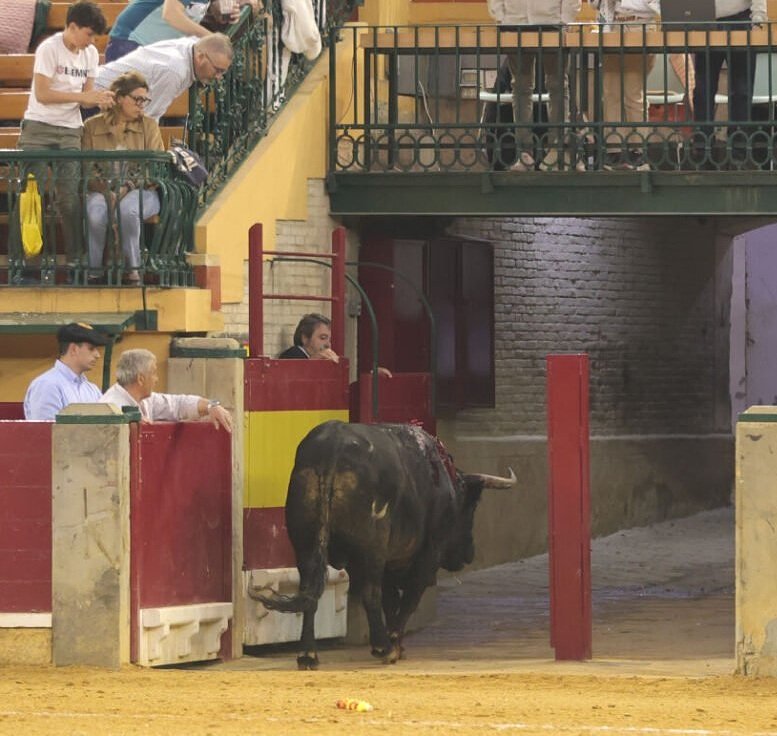Scandal at Zaragoza
(Image from mundotoro.com)
Earlier this year, the Real Unión de Criadores de Toros de Lidia (RUCTL) chose to write to the president of the Provincial Council of Valencia, the administration on which the taurine festivities in the Valencian capital depend, to reflect the complaints derived from what the Unión described as “the lack of ‘a single criterion’ in the veterinary examinations prior to each of this year’s Las Fallas festejos.” Now, the Unión may be forced to write a similar letter to Zaragoza’s authorities.
The disparity of opinions with Valencia’s veterinarians had a serious impact on the ganaderos, preventing bulls selected and prepared for Las Fallas, from being able to go out to the ring - in their entirety on some occasions, while on others, the strings had to be added to with bulls from other ranches.
“This lack of rigour,” the Unión complained, “also conditioned by the criteria of the different presidents appointed for each festejo, has turned the recently completed feria into real livestock chaos […] We urge the Provincial Council of Valencia to take the appropriate measures in order to redirect a situation that has been repeating itself year after year, and to define a livestock criterion by virtue of which the bull that should enter the bullring of Valencia is determined."
Zaragoza also has a reputation as a first class bullring where the veterinarians have forthright opinions of their own, and this situation reared its head in the closing April 23 corrida of the recent Feria de San Jorge. The announced bulls of Julio de la Puerta - a reputable ganadería, renowned for the number of indultos its bulls have been given in recent years - were all rejected by the Zaragoza vets. Twenty-four hours later, the ganadero still had no idea as to why this had happened: “We don't know why they’ve rejected the bulls,” said Julio de la Puerta. “The mayoral has asked, but they still haven't sent us the documentation, and I don't think it's because the animals are useless. I am waiting to be able to contact the empresa so that he can provide us with the information.”
The announced substitutes were bulls of Castillejo de Huebra, but in the end only four of these were selected for the six bulls to be fought, the other two coming from the sister ranch of José Manuel Sánchez. The long-suffering afición of Zaragoza made their views known from the corrida’s start. As Javier Jiménez reported for mundotoro: “The first bull of the afternoon had not come out and the aficionados were already clamouring about the situation in Zaragoza [… The approved bulls were] animals of gigantic proportions, some of them of negligible trapío due to their lack of expression and poor shape, and all of them inappropriate for toreo. It would be a miracle if anything good happened […] if Pamplona is characterized by choosing a bull for the encierro, Zaragoza is characterized by embarcations thinking about the midday reconicimiento and the plaza’s prejudice - the coarsest and the largest animals, although always within a certain price.” Carmel Moya, writing in El Periódico de Aragón, was of a similar view: "What arrived at the corrals was a real sindios, a jumble of sizes, ages and make-up worthy of the most remote village, never of a bullring like Zaragoza’s.”
A disastrous corrida duly unfolded. David Galván faced two bulls - one from each of the day’s ganaderías (his second a replacement castillejo after a late decision by the presidente to send an invalid bull back to the corrales) - that were deslucidos, lacking in aggression and emotion and which ended up manseando and en tablas before the matador took the estoque. He consequently had the unfortunate experience of hearing three avisos on both his animals. Both ended up walking along hugging the boards and making a descabello near impossible. They were both returned to the corrales, the last of these, fatally injured, falling a number of times on its wretched journey.
Borja Jiménez drew the best of the bad lot, although his first bull’s reluctance to charge was a contributing factor in a spectacular cogida for Tristán Barroso during a quite. The sevillano even managed some linked derechazos with his second manso before it, too, sought the tablas.
In only his second corrida, Tristán Barroso faced a 660-kilo monster to start with, while his other castillejo was devuelto because of its lack of strength and replaced with a José Manuel Sánchez sobrero that proved to be a manso de solemnidad.
Javier Jiménez, who report was correctly titled ‘Bullfighting should take better care of its image’, summed up the ending: “The pitiful spectacle almost lasted three hours. The plaza cried out in unison against the empresa: ‘Zúñiga, vete [go now]!’ [It was] the umpteenth fall of Zaragoza and a crowd tired of outrages in a display that should make everyone think. It is not a matter of complying expediently with a contract, but of reasoning out bullfighting and trying to attain the height of a first class bullring and of toreo.”
